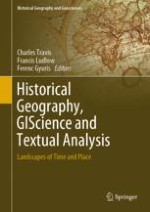2020 | OriginalPaper | Chapter
2. Digital Mapping and the Narrative Stratigraphy of Iceland
Author : Emily Lethbridge
Published in: Historical Geography, GIScience and Textual Analysis
Publisher: Springer International Publishing
Activate our intelligent search to find suitable subject content or patents.
Select sections of text to find matching patents with Artificial Intelligence. powered by
Select sections of text to find additional relevant content using AI-assisted search. powered by
